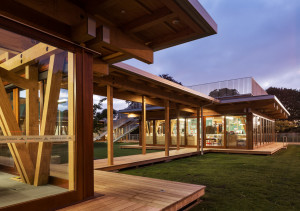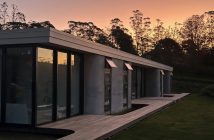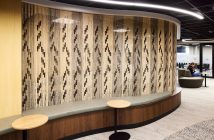Wood is no longer “just” a framing option for bungalows, as the NZ Wood-Resene Timber Design Award winners are proving
Nine winners in categories ranging from architectural excellence and engineered innovation to novel applications of fibre and student design were announced at a gala function in Auckland on March 9th.
The Resene Supreme Award went to Cathedral Grammar Junior School in Christchurch, submitted by Ruamoko Solutions with Andrew Barrie Lab, Tezuka Architects, Ohno Japan and Contract Construction.
“Cathedral Grammar stands out as an example of what can be achieved with effective collaboration and innovation in timber design, fabrication and construction,” the judges said.
“The expression of the structural timber frames at a human scale is inviting, and promotes a tactile response from young occupants.”
This entry also won Timberlab Solutions Ltd’s Commercial Architectural Excellence section and was highly commended in the XLam NZ/Nelson Pine Industries’ Engineering Innovation one.
Jon Tanner, Wood Processors and Manufacturers’ Association’s (WPMA) chief executive, points out that wooden buildings weigh less than comparable steel-concrete structures – a major advantage in fine, liquefaction-prone soils.
Engineered beams in laminated veneer lumber (LVL) or cross laminated timber (CLT) can provide equivalent strength and improved fire resistance to steel beams, which can warp dangerously in extreme heat. Timber chars, but rarely burns right through.
“Modern timber construction methods mean multi-storey residential and commercial complexes are being built worldwide, some up to 18 storeys tall,” says Debbie Fergie, WPMA’s Promotion Manager.
“Astute asset owners are taking advantage of the cost effective solutions such buildings can provide. Such structures are erected very quickly compared to others too.”
Wood’s inherent flexibility can also be maximised in infrastructure applications, as demonstrated in the Kopupaka Park solution in Northwest Auckland that won Smartclad’s Exterior Innovation and Infrastructure award.
This was submitted by Isthmus Group Ltd, and judges gave kudos to the team for “thinking outside the box and using timber for infrastructure projects.” This project had earlier won the Landscape of the Year award at the 2016 World Architecture Festival in Berlin.
The Carter Holt Harvey-sponsored Residential Architectural Excellence category was won by the Point Wells Gables project , designed by Aaron Paterson and Steven Lloyd of the Paterson Architecture Collective, Steven Lloyd Architecture and Glamuzina Architects.
Judges commented, “The use of traditional timber technologies, highly manipulated and carefully detailed, achieves high emotional impact.” This project was also highly commended in the Interior Innovation category and was the only entry to be highly commended in the Resene Supreme Award.
Winner of the Interior Innovation category, sponsored by Taranaki Pine, was another Auckland project. This was the Government of Samoa’s Fale in Mangere, from Walker Community Architects Ltd.
“Traditional methods of building have been scaled up to make a large community space, while maintaining the…richness derived from shaped and honed timbers and traditional bound joints,” said the judges.
The Innovation of Student Design Award was won by two third-year University of Auckland students – “Marking the Journey of Tatau” (tattooing) from Amanda Wijaya is described as a progression through a building likened to the three stages of tatau – the stretching, the tattooing, and the transition to adulthood, enhanced by the louvered and coffered rafters, ceiling and panels.
The second winner was a multifunctional pavilion by Louie Tong. “Rigorous mathematical and geometrical analysis has informed a student design and build project at Henderson High School, which can be seen as a deliberate provocation to engage students’ imagination and interest in mathematics, material and construction,” said judges.



